

ARGENTINA, 2001, and its FDI cancel with the IHS on a Jesuit weather vane, Scott 2160
JESUIT
INSTITUTIONS |


ARGENTINA, 2001, and its FDI cancel with the IHS
on a Jesuit weather vane, Scott 2160
ARGENTINA, 2010, postal card for the National Philatelic Exposition for the Bicentenary of the Camino Real
featuring Scott 2160b at the lower left with the estancias (left to right) of Candelaria, Alta Gracia, and Jesús María
Sheets of these stamps contain a central column of labels (left above) which bear the title page of the 1615 Directory of St. Ignatius' Spiritual Exercises. The middle stamp above shows a carved angel and around it clockwise: the Jesuit Block sketched in white on an orange-red background, the monogram of the Society, the estancias of Caroya and of Santa Catalina. The right stamp shows, beneath the monogram of the Society, the estancias (from left to right) of Candelaria, Alta Gracia, and Jesús María, and faintly in the background, the floor plan of the block.
The Jesuit Block and the Estancias were declared to be part of the Cultural Heritage of Humanity by UNESCO in 2000. They described it thus "The Jesuit Block in Córdoba, heart of the former Jesuit Province of Paraguay, contains the core buildings of the Jesuit system: the university, the church and residence of the Society of Jesus, and the college. Along with the five estancias, or farming estates, they contain religious and secular buildings, which illustrate the unique religious, social, and economic experiment carried out in the world for a period of over 150 years in the 17th and 18th centuries." The Jesuits had settled in Córdoba in 1599 and made it the hub of their work in River Plate area and Tucumán area. The Block includes specifically the National University of Córdoba, the National College of Our Lady of Montserrat, and the Jesuit church and residence. Income from the estates was used to support the apostolic work.
OCA, 2003UNESCO's declaration was also marked by OCA (Organización Coordinadora Argentina). When Correo Argentino was privatized in 1997, OCA became one of that country's private postal services, its largest, and has issued stamps since that time. OCA issued two sets of private postal stamps to celebrate UNESCO's naming the Jesuit Block and the Estancias of Cordoba as part of the Cultural Heritage of Humanity: five stamps in 2002 picturing the estancias and four stamps in 2003 picturing the Jesuit Block. They are seen below.

ARGENTINA, 1988, the 4th centenary of the estancia, Scott 1622; OCA, Cultural Heritage of Humanity, 2002
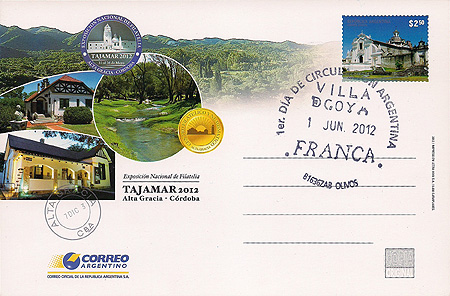
ARGENTINA, 2012, postal card and FDI cancel for National Philatelic Day, the stamp featuring the estancia
ARGENTINA, 2015 a semi-postal set of four clocks contains this stamp showing the Jesuit estate sundial at Alta Gracia, Scott B223Estancia Alta Gracia dates from 1643. Its chapel is now the parish church of the city. The Jesuit residence in 1810 became the property and residence of Santiago de Liniers, Viceroy of the River Plate, and is now a National Historical Museum.
OCA, Cultural Heritage of Humanity, 2002Estancia Caroya, the first to be set up by the Jesuits (in 1616), later served as an arms factory and was used by the Army of the North during the wars of national independence.
OCA, Cultural Heritage of Humanity, 2002Estancia Jesús María was the second Jesuit estancia set up (1618); it is in an area good for the production of high quality wine, which is still produced there today.
OCA, Cultural Heritage of Humanity, 2002Estancia La Candelaria (1683), high in the mountains, is an extensive breeding ranch especially of mules.
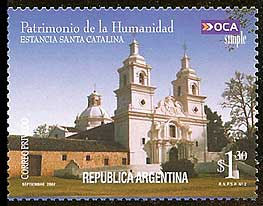
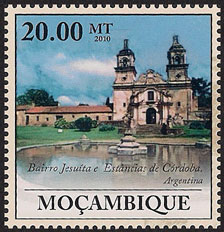
OCA, Cultural Heritage of Humanity, 2002
MOZAMBIQUE, 2010, one stamp out of 12 souvenir sheetss honoring UNESCO's
Cultural Heritage of Humanity choices,
which is entitled Jesuit Block and Estancias of Cordoba, Argentina, pictures
Santa Catalina, Scott 2051f
Estancia Santa Catalina, the largest, was established in 1622, a great center of farming and a center for blacksmithing, carpentry, weaving and other kinds of crafts.
The Candonga Chapel, Estancia Santa Gertrudis

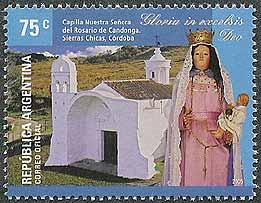
ARGENTINA, 1978, Scott 1173
ARGENTINA, 2005, the chapel and statue of Our Lady of the Rosary of Candonga, Scott 2341,
and its FDI cancel for four religious sites including the Candoga chapel (at 9 o'clock)The Jesuits did not build, but bought the Estancia of St. Gertrude (or more properly the Estancia of the Rosary of St. Gertrude) in Sierra Chicas, Córdoba. Among the improvements they made was the building in 1730 of this small chapel in honor of the Virgin as the oratory of the estancia, the Capilla Nuestra Señora del Rosario de Candonga, in quite a different style from the usual Baroque. Candonga is about 30 miles north of Córdoba, the threshold to the high country, and one of the main mule posts on the Royal Trail that leads to the high country of Peru. The fact is reflected in the name, Candonga, an old Castilian word for "loaded mule." The Chapel was declared a National Historical Monument in 1941.
The National Library of Argentina, Buenos Aires
ARGENTINA, 2010, the bicentennial of the library, Scott 2595This library began in a former Jesuit building. The National Library of the Argentine Republic is the largest library in Argentina and one of the most important in the Americas. It was originally named the Public Library of Buenos Aires and was founded in September 1810 by the government, not the Jesuits who were suppressed at this time. In 1884 it redefined its mission and changed its name to the National Library of Argentina. The first headquarters was an old 18th-century mansion that belonged to the Jesuits, located on the corner of Moreno Street and Peru Street, within the historic Jesuit site known as the Manzana de Las Luces (The Illuminated Block). The Jesuits came to Buenos Aires and established their mission there in 1608, but in 1661 acquired the Block where they established the Parish of St. Ignatius begun in 1686, completed in 1722, and the adjoining College of St. Ignatius, built between 1710 and 1729, the city's finest laboratories, museum and library. The center also housed the Mission Superior who oversaw the Indian Reductions, and the city's first pharmacy opened and operated by an Irish Jesuit, Father Thomas Falkner. After the Suppression closed the mission in 1767 , the academy was converted in 1772 into the Royal College of San Carlos, the church became a cathedral in 1775, and the pharmacy formed the basis for Viceroy Juan José de Vértiz's Medical Court of 1780, the first school of medicine in what is today Argentina.
The National University of Córdoba

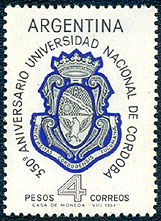
ARGENTINA, 1964, the 350th anniversary of the National University of Cordoba, Scott 764
and two color errors, one omitting gold, the second blue and gold

A detail of Scott 764 (above) and its FDI cancel


OCA, Cultural Heritage of Humanity, 2003
ARGENTINA, 1971 and 2009, the Observatory of the National University of Córdoba, Scott 969 and 2548

ARGENTINA, 2013, 4th centenary of the University, and its FDI cancel, Scott 2681The National University of Córdoba was founded by the Jesuits as the University of Tucumán in 1613 through a generous gift of the Bishop of the Tucumán, Fray Fernando de Trejo and Sanabria. It was directed by them until the Suppression, the Jesuit monogram IHS at the top of the coat of arms (see detail) a subtle reminder of the fact. One of OCA's 2003 stamps pictures the "House of Trejo," as the old seat of the University is called. The building was originally a single story, its patio the first botanical garden. It has been modified often over the years, the latest time in 2000. The school became a public institution in the 19th century, one of the most prestigious in Latin America, and now has a population of more that 100,000 students coming from all over Argentina as well as from abroad.
The National College of Our Lady of Montserrat, Córdoba

ARGENTINA, 1987, the tercentenary of the college, souvenir sheet, Scott 1591; OCA, Cultural Heritage of Humanity, 2003The National College of Our Lady of Montserrat is a secondary school founded by the Jesuits in 1687 on the southeastern corner of the Jesuit Block. Among its graduates are leaders of the emancipation and of the National Organization like Juan Jose Paso, Juan Jose Castelli and Jose Maria Paz. It housed the first printing press in the River Plate Vice-royalty.
The Jesuit Church and Residence, Córdoba
OCA, Cultural Heritage of Humanity, 2003OCA's 2003 set pictures the Domestic Chapel of the Jesuit Residence (1644-1668) (above left) and the public Church of the Society of Jesus (1640-1676) (above right), both in the Jesuit Block in Córdoba. The domestic chapel, for private use by the Jesuit community, shows an exquisite balance of aesthetics and engineering. Its altarpiece and its ceiling, like that of the main church, demonstrate the splendor of American Baroque.
The public Church's austere facade contrasts with the rich ornamentation of its interior. It is built in the shape of a Latin cross with a chapel to either side (in former days the north chapel was for the natives, the south one for the Spaniards). The vault is built in the shape of inverted keel, the altarpiece and the pulpit adorned with gold leaf. Fr. Manuel de Cabrera, SJ, nephew of the founder of the city, during his studies in Spain made a donation of his entire heritage to underwrite the cost of this church for Córdoba. The church was built to the top of the walls, but no one in Córdoba understood how to build the arches and cupola. Philip Lemer from the area of Belgium, a man skilled in building, arrived in the country, became a Jesuit brother and learning the necessary skills from a French textbook completed the structure, which was finally dedicated in 1671, the same year Lemer died.
SPAIN, 1974, a series on Spanish influence in the Americas, Scott 1842The reducción or mission of San Ignacio Mini lies about 35 miles east of Posadas, the capital of Argentina's Misiones province. It is called mini, Guarani for small, to distinguish it from the St. Ignatius mission in Paraguay called guazú, Guarani for large. Founded in 1611, it is the most prosperous and important of the 30 such settlements developed by the Jesuits in this area, and its ruins the most impressive. It is the work of the Jesuit brother and architect Gianbattista Primoli. The Baroque church, the doorway of which is featured on so many stamps, was built in 1724 following the designs of Br. Giuseppe Brasanelli (1659-1728). In 1983 UNESCO declared these ruins to be part of the Cultural Heritage of Humanity.


ARGENTINA, 1978, Scott 1172, 1174-75


ARGENTINA, 1982, Scott 1389 and 1998, the Mercosur commemoration of Jesuit Missions, Scott 2005
ARGENTINA, 2004, Scott 2301C

ST. VINCENT & THE GRENADINES, 1997, a souvenir sheet honoring the 50th anniversary of World Heritage,
incorrectly identifying this ruin as in Paraguay, Scott 2395a, 2395

ARGENTINA, 1988, one stamp in this mini-sheet pictures Distribution of Candles in San Ignacio Mini by Leonie Matthis, Scott B136a, B13
ARGENTINA, cinderella from the Direccion Provincial de Turismo
featuring San Ignacio Mini
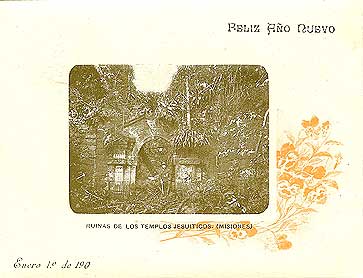

ARGENTINA, 1901 to 1903, the inside of New Year greeting postal envelopes, a 5 centavos stamp is imprinted stamp on the cover;
four side flaps would fold over various pictures of doors of the church of San Ignacio Mini and the title "Ruinas de los templos Jesuiticos (Misiones)"